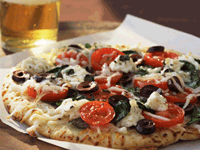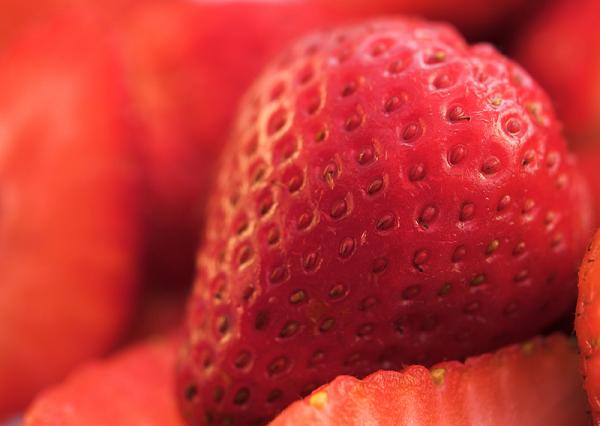The potato is thought to have originated in what is now Peru, on the shores of lake Titicaca. Native Peruvians such as the Quechua have been highly dependent on the potato for thousands of years. A 1964 study of the Quechua inhabitants of Nuñoa showed that they obtained 74% of their calories from potatoes (fresh and chuños), 10% from grains, 10% from Chenopodia (quinoa and cañihua), and 4% from animal foods. Total energy intake was 3,170 calories per day (1).
In 2001, a medical study of rural Quechua men reported an average body fat percentage of 16.4% (2). The mean age of the volunteers was 38. Body fat did increase slowly with age in this population, and by age 65 it was predicted to be about 20% on average. That's below the threshold of overweight, so I conclude that most men in this population are fairly lean, although there were a few overweight individuals.
In 2004, a study in rural Quechua women reported a body fat percentage of 31.2% in volunteers with a mean age of 35 (3). Body fat percentage was higher in a group of Quechua immigrants to the Peruvian capital of Lima. Among rural women, average fasting insulin was 6.8 uIU/mL, and fasting glucose was 68.4 mg/dL, which together suggest fairly good insulin sensitivity and glucose control (4). Insulin and glucose were considerably lower in the rural group than the urban group. Blood pressure was low in both groups. Overall, this suggests that Quechua women are not overweight and are in reasonably good metabolic health.
Rural Quechua are characteristically short, with the average man standing no more than 5' 2" (2). One might be tempted to speculate that this reflects stunting due to a deficient diet. However, given the fact that nearly all non-industrial populations, including contemporary hunter-gatherers, are short by modern standards, I'm not convinced the Quechua are abnormal. A more likely explanation is that industrial foods cause excessive tissue growth in modern populations, perhaps by promoting overeating and excessive insulin and IGF-1 production, which are growth factors. I first encountered this hypothesis in Dr. Staffan Lindeberg's book Food and Western Disease.
I don't consider the Quechua diet to be optimal, but it does seem to support a reasonable level of metabolic health. It shows that a lifetime high-carbohydrate, high glycemic index, high glycemic load diet doesn't lead to insulin resistance and obesity in the context of a traditional diet and lifestyle. Unfortunately, I don't have more detailed data on other aspects of their health, such as digestion.
Potato-eating Cultures: the Aymara
The Aymara are another potato-dependent people of the Andes, who span Peru, Bolivia and Chile. The first paper I'll discuss is titled "Low Prevalence of Type II Diabetes Despite a High Body Mass Index in the Aymara Natives From Chile", by Dr. Jose Luis Santos and colleagues (5). In the paper, they show that the prevalence of diabetes in this population was 1.5%, and the prevalence of pre-diabetes was 3.6%. The prevalence of both remained low even in the elderly. Here's a comparison of those numbers with figures from the modern United States (6):
That's quite a difference! The prevalence of diabetes in this population is low, but not as low as in some cultures such as the Kitavans (7, 8).
Now to discuss the "high body mass index" referenced in the title of the paper. The body mass index (BMI) is the relation between height and weight, and typically reflects fatness. The average BMI of this population was 24.9, which is very close to the cutoff between normal and overweight (25).
Investigators were surprised to find such a low prevalence of diabetes in this population, despite their apparent high prevalence of overweight. Yet if you've seen pictures of rural native South Americans, you may have noticed they're built short and thick, with wide hips and big barrel chests. Could this be confounding the relationship between BMI and body fatness? To answer that question, I found another paper that estimated body fat using skinfold measurements (9). That study found a body fat percentage of 15.4%, which is lean by any standard. Based on this paper and others, it appears that investigators shouldn't extrapolate BMI standards from modern Caucasian populations to traditional native American groups.
Back to the first paper. In this Aymara group, blood pressure was on the high side. Serum cholesterol was also a bit high for a traditionally-living population, but still lower than most modern groups (~188 mg/dL). I find it very interesting that the cholesterol level in this population that eats virtually no fat was the same as on Tokelau, where nearly half of calories come from highly saturated coconut fat (10, 11). Fasting insulin is also on the high side in the Aymara, which is also interesting given their good glucose tolerance and low prevalence of diabetes.
Potato-eating Cultures: the Irish
Potatoes were introduced to Ireland in the 17th century. They were well suited to the cool, temperate climate, and more productive than any other local crop. By the early 18th century, potatoes were the main source of calories, particularly for the poor who ate practically nothing else. In 1839, the average Irish laborer obtained 87% of his calories from potatoes (12). In 1845, the potato blight Phytophthora infestans struck, decimating potato plantations nationwide and creating the Great Famine.
There isn't much reliable information on the health status of the Irish prior to the famine, besides reports of vitamin A deficiency symptoms (13). However, they had a very high fertility rate, and anecdotal reports described them as healthy and attractive (14):
As far as fecundity is concerned, the high nutritional value of the potato diet might have played a significant role, but little supportive evidence has been presented so far... What is known is that the Irish in general and Irish women in particular were widely described as healthy and good-looking. Adam Smith's famous remark that potatoes were "peculiarly suitable to the health of the human constitution" can be complemented with numerous observations from other contemporary observers to the same effect.
Controlled Feeding Studies
Starting nearly a century ago, a few eccentrics decided to feed volunteers a potato-only diet to see if it could be done. The first such experiment was carried out by a Dr. M. Hindhede and published in 1913 (described in 15). Hindhede's goal was to explore the lower limit of the human protein requirement and the biological quality of potato protein. He fed three healthy adult men almost nothing but potatoes and margarine for 309 days (margarine was not made from hydrogenated seed oils at the time), all while making them do progressively more demanding physical labor. They apparently remained in good physical condition. Here's a description of one of his volunteers, a Mr. Madsen, from another book (described in 16; thanks to Matt Metzgar):
In order to test whether it was possible to perform heavy work on a strict potato diet, Mr. Madsen took a place as a farm laborer... His physical condition was excellent. In his book, Dr. Hindhede shows a photograph of Mr. Madsen taken on December 21st, 1912, after he had lived for almost a year entirely on potatoes. This photograph shows a strong, solid, athletic-looking figure, all of whose muscles are well-developed, and without excess fat. ...Hindhede had him examined by five physicians, including a diagnostician, a specialist in gastric and intestinal diseases, an X-ray specialist, and a blood specialist. They all pronounced him to be in a state of perfect health.
Dr. Hindhede discovered that potato protein is high quality, providing all essential amino acids and high digestibility. Potato protein alone is sufficient to sustain an athletic man (although that doesn't make it optimal). A subsequent potato feeding study published in 1927 confirmed this finding (17). Two volunteers, a man and a woman, ate almost nothing but potatoes, lard and butter for 5.5 months. The man was an athlete but the woman was sedentary. Body weight and nitrogen balance (reflecting protein gain/loss from the body) remained constant throughout the experiment, indicating that their muscles were not atrophying at any appreciable rate, and they were probably not putting on fat. The investigators remarked:
The digestion was excellent throughout the experiment and both subjects felt very well. They did not tire of the uniform potato diet and there was no craving for change.
In one of his Paleo Diet newsletters titled "Consumption of Nightshade Plants (Part 1)", Dr. Loren Cordain referenced two feeding studies showing that potatoes increase the serum level of the inflammatory cytokine interleukin-6 (22, 23). However, one study was not designed to determine the specific role of potato in the change (two dietary factors were altered simultaneously), and the other used potato chips as the source of potato. So you'll have to pardon my skepticism that the findings are relevant to the question at hand.
Just yesterday, Mr. Chris Voigt of the Washington State Potato Commission embarked on his own n=1 potato feeding experiment as a way to promote Washington state potatoes. He'll be eating nothing but potatoes and fat for two months, and getting a full physical at the end. Check out his website for more information and updates (18). Mr. Voigt has graciously agreed to a written interview with Whole Health Source at the end of his experiment. He pointed out to me that the Russet Burbank potato, the most popular variety in the United States, is over 135 years old. Stay tuned for more interesting facts from Mr. Voigt in early December.
Observational Studies
With the recent interest in the health effects of the glycemic index, a few studies have examined the association between potatoes and health in various populations. The results are all over the place, with some showing positive associations with health, and others showing negative associations (19, 20, 21). As a whole, I find these studies difficult to interpret and not very helpful.
Anecdotes
Some people feel good when they eat potatoes. Others find that potatoes and other members of the nightshade family give them digestive problems, exacerbate their arthritis, or cause fat gain. I haven't seen any solid data to substantiate claims that nightshades aggravate arthritis or other inflammatory conditions. However, that doesn't mean there aren't individuals who are sensitive. If potatoes don't agree with you, by all means avoid them.
The Bottom Line
You made it to the end! Give yourself a pat on the back. You deserve it.
In my opinion, the scientific literature as a whole, including animal and human studies, suggests rather consistently that potatoes can be a healthy part of a varied diet for most people. Nevertheless, I wouldn't recommend eating nothing but potatoes for any length of time. If you do choose to eat potatoes, follow these simple guidelines:
* Don't eat potatoes that are green, sprouting, blemished or damaged
* Store them in a cool, dark place. They don't need to be refrigerated but it will extend their life
* Peel them before eating
 With many western diets revolving around high fat junk foods, fruit health benefits are not something that should be ignored. Consuming plenty of fruit in your diet is an excellent way of staying healthy and reducing your chances of developing a life threatening illness.
With many western diets revolving around high fat junk foods, fruit health benefits are not something that should be ignored. Consuming plenty of fruit in your diet is an excellent way of staying healthy and reducing your chances of developing a life threatening illness. Fruit also contains plenty of fibre, which is very important for keeping the human digestive system working properly. A diet packed full of fruit can help the body to efficiently expel waste products, which includes the toxins that can lead to colon and bowel cancer.
Fruit also contains plenty of fibre, which is very important for keeping the human digestive system working properly. A diet packed full of fruit can help the body to efficiently expel waste products, which includes the toxins that can lead to colon and bowel cancer.



































